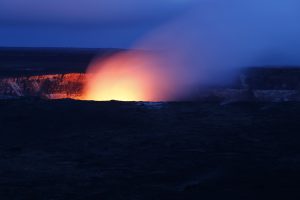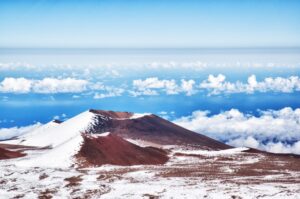This week, as part of our ongoing series for Women’s History Month, we’re exploring goddesses. Many folks know about the goddesses of the ancient Greek and Egyptian pantheons, but many other indigenous traditions also adore their female deities. In fact, most goddess customs exist because people refused to let them vanish into the annals of history. The goddesses are powerful, much-beloved, and here to stay. Here are two from the Hawaiian tradition.

Pele {PAY-lay} is the well-known fire goddess. As goddess of volcanoes, she is also a creator goddess in the Hawaiian tradition. Her home is the crater of Kilauea, the most active volcano on the “big island” of Hawaii. One of the most famous Pele legends centers on Kamehameha I, who unified the Hawaiian islands in the late 1700’s with the help of the god of war. According to the story, in 1801, perilous lava flows threatened the valuable trees, homes, and fish ponds of the island. Inhabitants frantically threw prayers, songs, and live pigs Pele’s way, but nothing appeased her wrath. Finally, after consulting with his seers, Kamehameha, himself, offered Pele a lock of his hair. She accepted the offering and the lava flow ceased.
If you visit the Kilauea caldera, you will surely see offerings of gin, flowers, and fruit. But on the day I visited, I got the distinct impression that Pele also enjoys 7-Up and cigarettes!! The important point is to treat her with honor and respect. In return, she will provide lava-flow protection for you, your family, and your property. Not to spoil your festive mood, but think twice before dumping your own offerings at the summit. Park rangers are assigned the task of regularly removing the gifts, and they consider them to be litter, so think about honoring Pele with a song instead. If she is pleased, she might even appear to you as a voice on the wind or as an old woman with long, white hair who is dressed in white.

Poli’ahu is one of the Hawaiian snow goddesses. Her home is Mauna Kea, another volcano that forms the “big island. ” Unlike Kilauea, Mauna Kea hasn’t erupted in over 4,000 years, and many Hawaiians offer their thanks to Poli’ahu for that. As with many things Hawaiian, the summit of Mauna Kea is an interesting, and sometimes tense, mix of the very ancient and the ultra-modern. At almost 14,000 feet above sea level, the peak offers clear skies near the equator, which makes it a a near-perfect astronomical observatory. Over a dozen state-of-the-art telescopes bend their scientific eyes toward the heavens, ignoring the pilgrims who occasionally ascend the mountain to offer sacred ceremonies honoring their ancestors, the land, and Poli’ahu.
According to legend, Poli’ahu and her three sisters were created by Kane, a sky deity and creator god. The four wise women lived near their sacred pond, which Kane provided for them as a source of bathing and drinking water. This unique lake still exists on Mauna Kea’s summit, tightly guarding her own secrets. It is the only alpine lake on the Hawaiian islands — a state with very few lakes to begin with. And although Lake Waiau was probably formed by a glacier, no one knows why it continues to exist. The altitude and surrounding geography should have forced it to dry up ages ago! It’s also one of the shallowest lakes on the islands. Despite that, it has long-been known as the “bottomless lake” and as a portal to the Underworld.
Pele and Poli’ahu
As you might imagine, there is a fair bit of tension between Pele and Poli’ahu, the two great goddess who reside on the same island. Here is the our version of the tale that describes the origins of their centuries-old feud.
One day, Poli’ahu and her sisters were racing their sleds down the slopes of Mauna Kea. A stranger of outstanding beauty suddenly appeared in their midst. She didn’t have a sled, so Poli’ahu loaned her one. The races continued, and Poli’ahu won the first race easily. The stranger was visibly displeased, so Poli’ahu exchanged sleds with her only to win handily the second time, too. By the third race, the stranger had tired of losing. She blocked Poli’ahu and her sled with streams of scorching lava and bursts of flame. Unable to hide her rage, Pele had revealed herself. Poli’ahu, completely stunned, quickly headed for her summit home, but Pele was not to be ignored. The mountains rumbled as the conflict raged between fire and snow. Rivers boiled over from the fiery rocks. Frozen rain fell in an attempt to quench the infernos. Eventually, the icy blizzards won, and the lava flows turned to hardened rock, but the two powerful goddesses continue their island battles to this day. Pele still rules Kilauea. Poli’ahu resides on Mauna Kea. And the battle continues over Mauna Loa.
Stay tuned later this week when we explore goddesses in the Shinto and Maori traditions!
Click on these links to see our previous Women’s History Month posts on Kids’ book authored/illustrated by women.
Kids Books on Islam
Kids Books on Buddhism
Kids Books on Judaism
Kids Books on Hinduism
Click on these links to see our previous Women’s History Month posts on women saints in various faith traditions.
Female Saints in Hinduism
Female Saints in Christianity
Female Saints in Buddhism